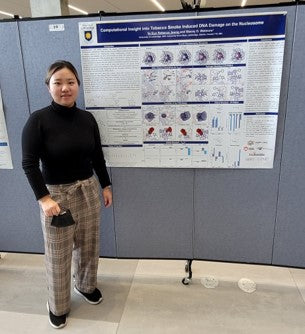Hello, I am Rebecca. I am currently doing a Ph.D. in Theoretical and Computer Science with a concentration in chemistry. In the field of life science, I am in the field of computational chemistry, which is a type of chemistry that uses computers to assist in solving chemical problems.
In the field of experimental chemistry, there are some limitations: some reactions are too dangerous to be performed in the lab (e.g., explosive chemicals and toxic gas), happen too quickly that they cannot be observed in real-time (e.g., rearrangement of molecules happening within femtosecond - a millionth of a billionth of a second), or if it happens in the very small scale (e.g., atomic level).
Example: a chemical reaction catalyzed by enzyme (learn more)
By using computers, I could simulate how the molecules behave in the chemistry and biochemistry experiments. In particular, I use computers to explore the impacts of DNA damage arising from a variety of environmental sources including food dyes, tobacco smoke, and fungus found on crops. On a day-to-day basis, I also review new literatures including the latest research results and new software tools.

An artistic (left) and more realistic (right) depiction of the enzyme RNAP, which converts strands of DNA to complementary strands of RNA. Zero to Genetic Engineering Hero book Figure 4.21, 4.22
I decided to join the research field of life science in my undergraduate program. During the third year of my Bachelor’s degree, I was introduced to a theoretical field of biochemistry where mathematical equations are used to describe the reaction rate (i.e., how fast the reaction occurs) in enzymes found in the biological system.
From the theoretical field of life science, I wanted to apply my skills in different fields of chemistry so I took opportunities to take a summer research job at the university. From the summer research job, I learned different techniques used in computational chemistry and worked on computer-aided nucleic acid aptamer.
The nucleic acid aptamer is a special class of nucleic acids folded into secondary and tertiary structures to bind to specific targets. It is now a commonly used method in the detection of toxins as they are relatively stable and cost-effective.
I was fascinated by its capabilities with applications in various fields including drug design, designing biotechnology tools (e.g., synthetic molecules to sense toxins like heavy metals), etc. Therefore, I decided to pursue a Ph.D. in computational chemistry.

One advice for students interested in joining life science is to take time to try different fields of science and find their interest before settling in one field. There are lots of great opportunities to see what life in life science is like through summer internships.